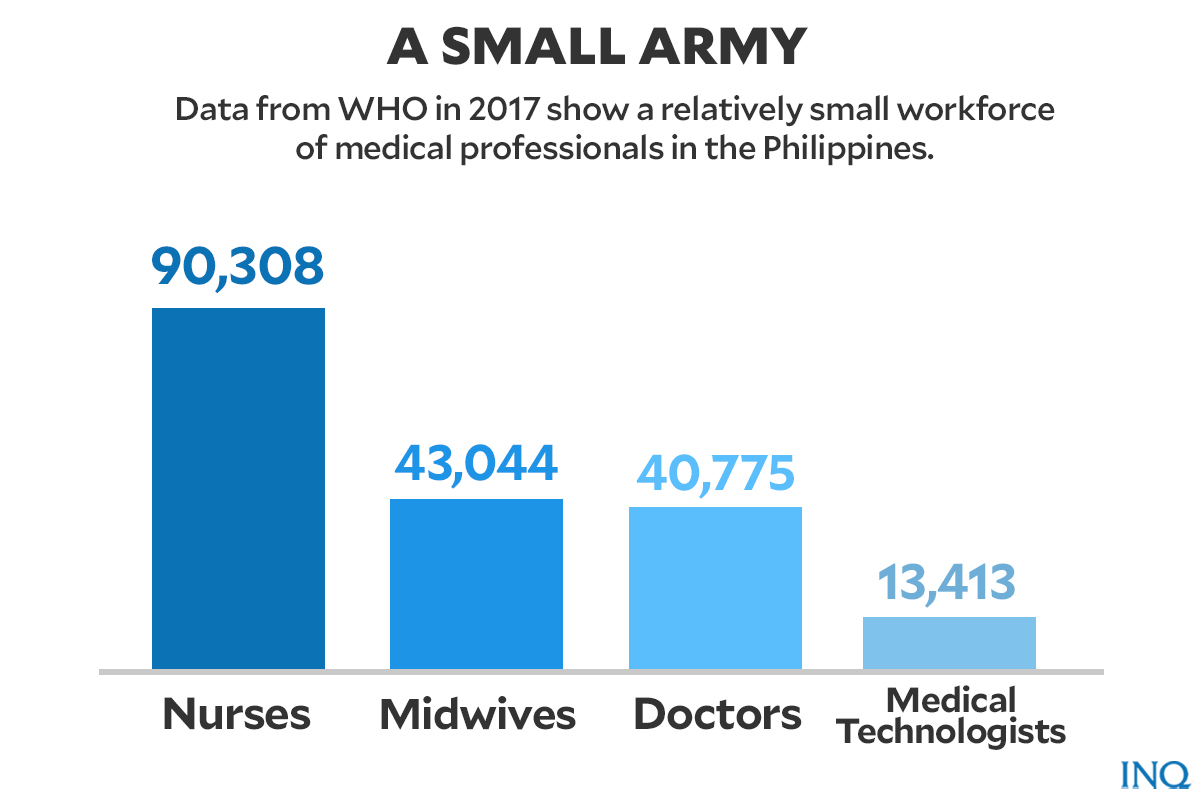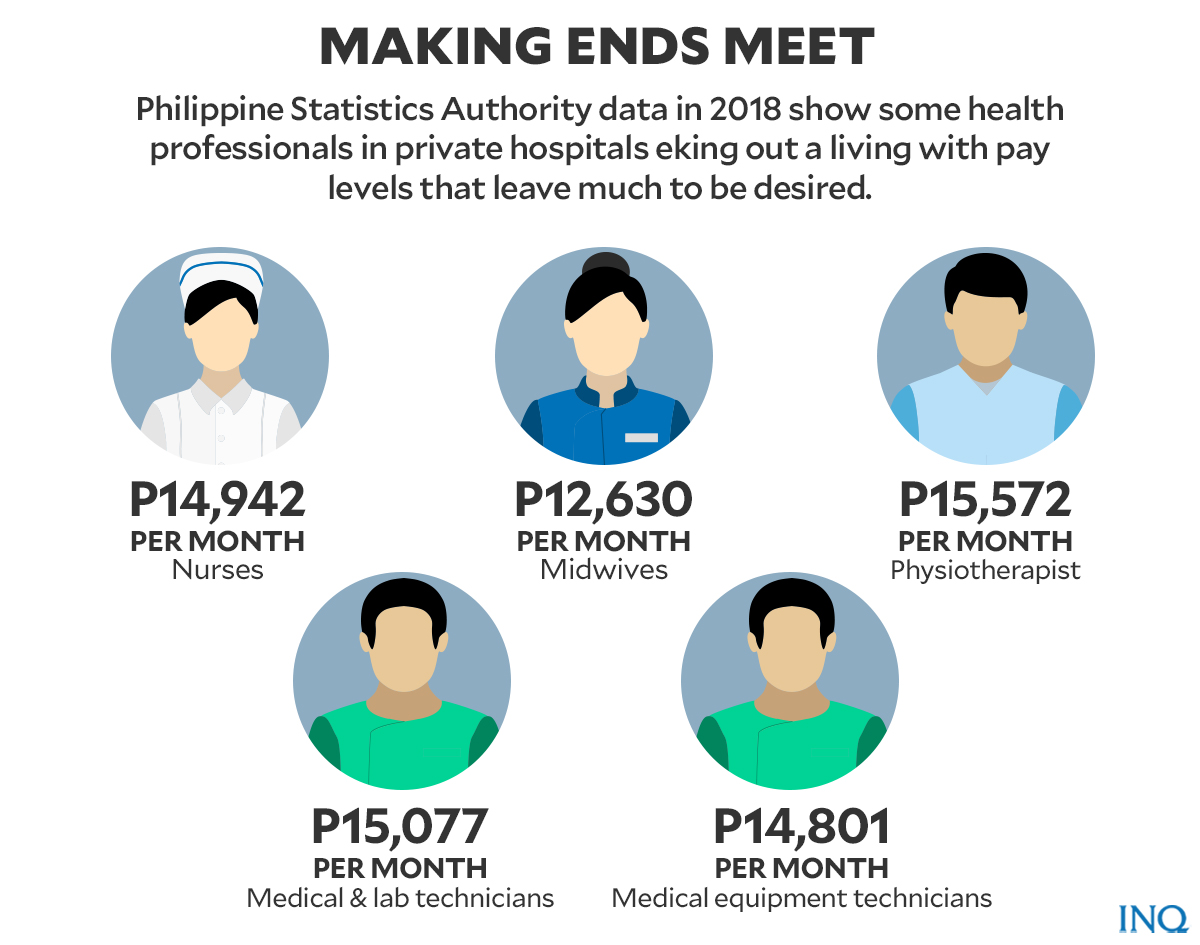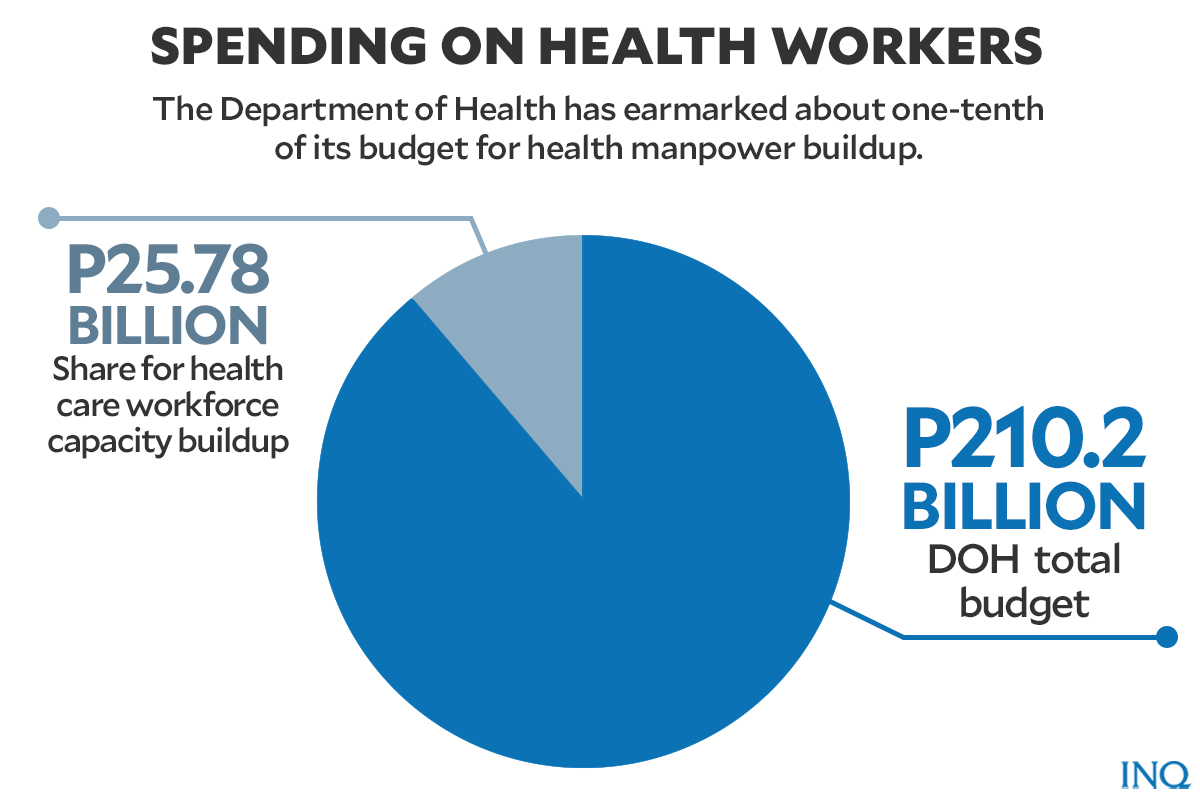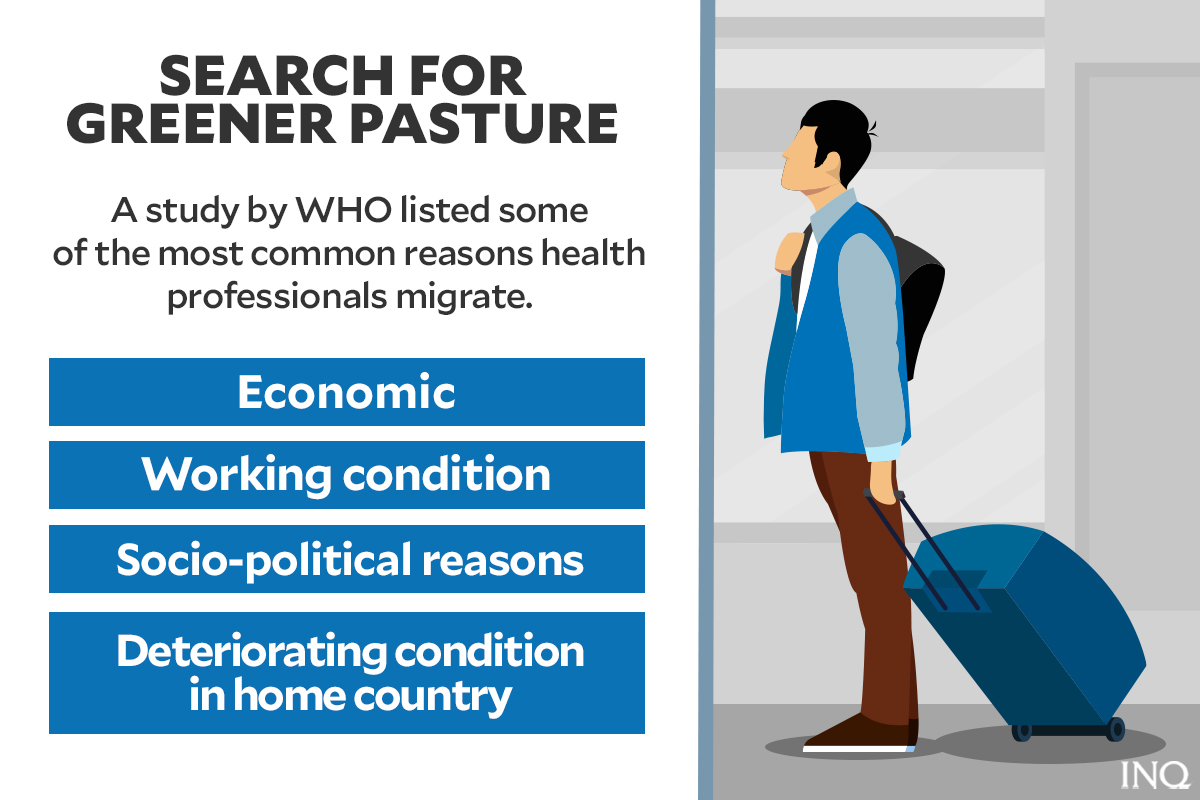PH health workers: A pandemic of big work, small pay
MANILA, Philippines—The coronavirus pandemic laid bare the sacrifice of the country’s health workers and also the state of their financial health.
Lauded as heroes in scrubs, these medical professionals on the frontline of the battle to keep COVID-19 cases from getting out of control had been through exhaustion and being overwhelmed by often 24-hour work. Many have lost their lives, falling victims themselves to the disease which has no known cure yet.
Heroes in scrubs: Remembering the lives of medical workers who died in the fight vs COVID-19
Supply of health workers
The 2015 Census of Population showed that there are nearly half a million—488,800—health professionals in the Philippines.
According to 2017 data from World Health Organization (WHO), nurses outnumber other health workers in the Philippines. There are 90,308 nurses compared to 40,775 doctors, 43,044 midwives and 13,413 medical technologists.
In the Philippines, WHO said the ratio of doctors to population is about six per 100,000 in 2017, the latest data available. The ideal, or recommended, ratio was 10 per 100,000.
In institutions, the ratio of health professionals per 100,000 people also in 2017 was:
- Doctors: 3.9 per 100,000
- Nurses: 8.6 per 100,000
- Midwives: 4.1 per 100,000
- Medical technologists: 1.3 per 100,000
In other Southeast Asian countries, the ratio was higher. Singapore has 23 doctors per 100,000. Vietnam, Thailand and impoverished Timor Leste have each eight doctors per 100,000 people.
Financial wellbeing
According to the Philippine Statistics Authority’s (PSA) 2018 Occupational Wage Survey, the highest-paid medical professionals in the Philippines are those with specializations. Their average monthly wage is P54,090. These are mostly specialists on heart diseases, cancer and others.
General medical practitioners—doctors and dentists—had the third highest average monthly earning—P33,592 and P28,123—which are above the national average for health professionals—P18,108, according to the PSA.
Other medical professionals working in private hospitals, however, earn less than the national wage average, according to the PSA:
These are:
- Physiotherapist: P15,572
- Medical and pathology laboratory technicians: P15,077
- Nursing professionals: P14,942
- Medical imaging and therapeutic equipment technicians: P14,801
- Accounting and bookkeeping clerks: P14,016
- Dieticians and nutritionists: P13,935
- Midwifery professionals: P12,630
- Unskilled workers except for janitors, messengers, and freight handlers: P11,581
“This level suggests that nurses and midwives in the country are living just above poverty threshold, based on the 2018 per-capita poverty threshold level for a household with five members,” said a report by the University of the Philippines (UP) Population Institute.
The report, published in August 2020, also said that about 10 percent of the country’s health workers live in poor households while over 80 percent belong to the middle class or higher.
A report published in 2020 by data aggregator iPrice Group showed that the salary for nurses and med techs in the Philippines is at the bottom of the pit in Southeast Asia.
PH salary for nurses, med techs lowest in Southeast Asia
Gov’t spending
Under the P4.5-trillion national budget for 2021 signed in 2020 by President Rodrigo Duterte, the DOH, as the lead agency for COVID-19 response, got a P210.2-billion budget, which was 19.6 higher than its 2020 budget.
At least P25.78 billion had been allocated for the Health Systems Straightening Program, which seeks to strengthen health workforce capacity.
Duterte signs P4.5-T 2021 national budget
The DOH, in its 2021 budget briefer, added that part of the budget would also be used to “support national and local health systems” through the deployment of 23,354 health workers.
The number included 744 doctors, 16,675 nurses, 4,538 midwives, 222 dentists, 303 pharmacists, 200 nutritionists, 601 med tech workers and 81 physical therapists.
A few months before the budget passed, a group of health workers urged Congress to give priority to health sector funding.
Migration amid shortage
Before the COVID-19 pandemic spread to the Philippines, the Human Resources for Health Network (HRHN), an inter-agency policy and program support network led by the Department of Health (DOH), estimated a shortage of about 290,000 health workers in the country.
The estimate was based on WHO’s calculations.
The deficiency in the country’s supply of health care professionals is also being aggravated by the average annual migration of 13,000 health workers.
In April 2020, the Philippine Overseas Employment Administration (POEA) suspended the deployment of health care workers abroad “to prioritize” human resources in the country, which has been struggling to combat the COVID-19 outbreak.
The deployment ban was lifted in December 2020, however, but a 5,000 cap on deployment of new-hires was kept.
The POEA on Tuesday (June 8) suspended the deployment of newly-hired health care professionals after the 5,000 cap has been reached.
Deployment of nurses abroad suspended as 5,000 quota reached – POEA
Two sides of the same coin
Amid increasing demand for medical professionals overseas, several Filipino health workers prepare to set sail and continue to work outside the country. However, registered nurse Victoria Carandang said she chose to stay and serve Filipinos amid the still increasing cases of COVID-19.
For Carandang, hearing a patient say thank you to her and other health workers is satisfaction enough.
“It is so worth it especially if we can help save lives,” Carandang said.
“It feels so nice whenever an unstable patient in the unit gets discharged and you will be surprised that they can remember you and thank you,” she added.
Carandang, who has been working as a nurse for a year, said she feels genuine happiness when her work is recognized and appreciated.
“I am happy that we are being recognized now during the pandemic,” she said in Filipino. “At last, our hardships are seen and acknowledged [by many]. I am also happy since I am doing my sworn duty as a nurse,” she said
“There is a fulfillment since I am doing my responsibilities and at the same time it is appreciated but at times I still ask myself, why only now?” Carandang said.
She will soon start work at another health facility after leaving her previous workplace. While the high and competitive salary offered by other countries can be tempting for health workers like her, Carandang said she will stay in the Philippines because it also provides her experience.
“It is really my choice to stay since I still need more experience. I feel like I will have more edge to work outside the country if I already have experience working in different areas of the hospital,” she said.
“Maybe after two years I will start to plan to work outside the Philippines,” she continued.
According to her, work during the pandemic carries so many difficulties, among them was restrictive movement in the hemodialysis units when it was time for her shift there.
She recalled missing meals and holding off on urinating. The work, she admitted, is also having an impact on mental health.
But the biggest disadvantage she and many other health professionals face is the lack of hazard pay and the measly amount of salary that are often not commensurate to the amount of work they provide.
“There is no hazard pay, we just hope that we have a strong guardian angel to protect us from contracting COVID,” she said in Filipino.
“Our workload is overwhelming and a lot of nurses have already resigned,” Carandang said. “We have long overtime but our salary is small. We almost live in the hospital, after few hours of sleep we will be back on our feet to do our rounds,” she said.
This level of work and pay has been constantly raised by many health care workers since the pandemic struck.
Health workers seeking pay hike say nothing has changed since pandemic started
For some, the disproportionate amount of work and pay was enough reason to seek greener pastures outside the Philippines.
In a Reuters article on Sept. 24, 2020, 34-year-old nurse April Glory was quoted as saying she was driven by financial need to work in the Middle East and leave her son behind.
“I felt that I was not earning enough,” she said in that report.
Pandemic ‘hero’ Filipino nurses struggle to leave home
According to a 2005 study by the International Labour Office (ILO) the migration of nurses, doctors, and other medical professionals can be attributed to several “push” and “pull” factors.
The push factors are:
- economics
- working conditions
- socio-political factors
- financial reasons
- ‘deteriorating condition’ in the home country
Most health workers seeking jobs abroad admit they do it for their children and families.
TSB
RELATED STORIES:
Overseas Filipino healthcare warriors in the time of COVID-19: For family and humanity
Barangay health workers: Unsung, underpaid, undaunted
Barangay health workers’ local knowledge is key to effective contact tracing
For more news about the novel coronavirus click here.
What you need to know about Coronavirus.
For more information on COVID-19, call the DOH Hotline: (02) 86517800 local 1149/1150.
The Inquirer Foundation supports our healthcare frontliners and is still accepting cash donations to be deposited at Banco de Oro (BDO) current account #007960018860 or donate through PayMaya using this link.


















